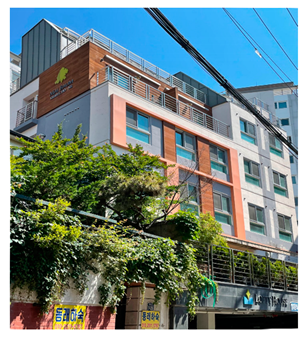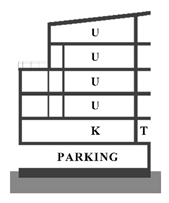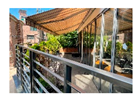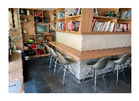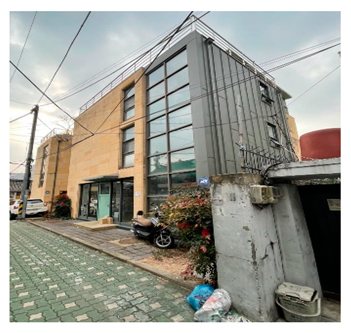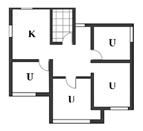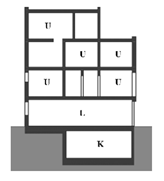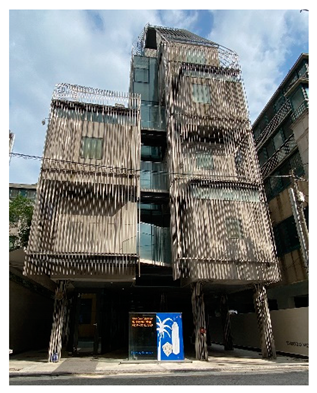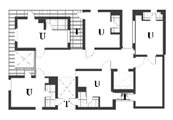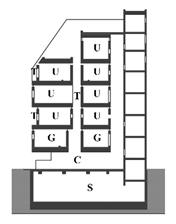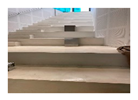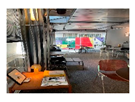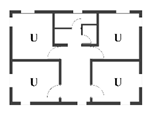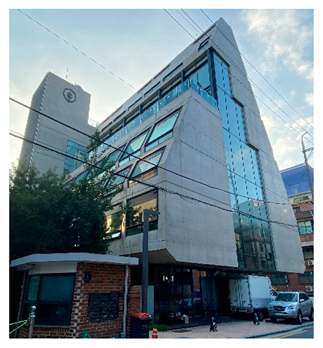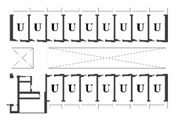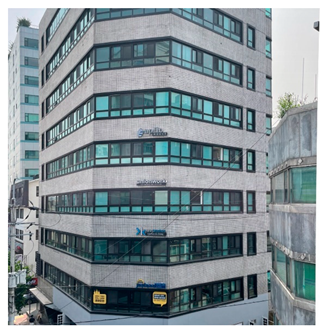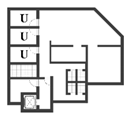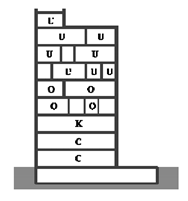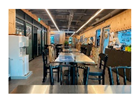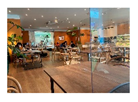Abstract
Among Korea’s household types, the demand for one-person housing, such as sharehouses, is noticeably increasing as lifestyle factors evolve. Sharehouses feature private bedrooms with communal spaces such as living rooms, kitchens, and bathrooms. This housing type has been supplied since 2010, yet its changes over time to meet demand have been underexplored. This study assesses the changing patterns of sharehouses by exploring six examples built between 2011 and 2019 and analyzing the changes in terms of communal space, personal space, and operating method. The results found that the later sharehouses eliminated the earlier sharehouses’ approach to uniform space configuration and operating methods, and manifested many changes (addition of work and cultural spaces; independent bathrooms and skip-floors to enhance privacy; and selection of residents being tailored to specific business/culture fields). Based on the findings, this study makes four suggestions to inform future spatial planning of sharehouses: (1) Spatial planning should reflect trends; (2) the target requirements for residents and ownership of sharehouses should be broadened; (3) operations and community programs should be developed; and (4) new laws and regulations specifically for sharehouses should be created.
1. Introduction
Examples of the “sharing economy” such as shared space, social interaction, and the joint use of resources are widespread [1]. As a household type, one-person housing is noticeably increasing with current global trends [2,3,4]. Household sizes have changed due to factors such as aging populations, decreasing marriage rates, change in average marriage age, and increasing divorce rates. For example, the average marriage age in Korea was 28.8 years for males, 26.0 years for females in 1998 and 33.4 years for males and 30.6 years for females in 2019 [5]. As a consequence, the types of destinations after leaving one’s home have also increased and diversified, with evidence of increases in non-marital cohabitation and sharing arrangements with non-family members [6]. Because of the social or communal bonds that may be engendered by sharing behaviors, sharing is likely to transform the spatial configurations of these spaces. There is an emerging trend of sharing-dedicated social spaces in many cities in the world today. Most notable among these shared spaces are the coworking cultural spaces where wider social ties and support networks are formed [7].
The development of this housing type has been almost entirely supply-side and developer-driven, yet the changes in sharehouses over time to meet demand have been underexplored, particularly regarding their changes in spatial configuration to meet evolving housing preferences [4].
To better understand the links between housing, home, and wellbeing, it is vital to understand home as something more than simply a material structure—home is lived, sensed, created, and rooted through everyday practice. Residents of sharehouses often speak about a lack of privacy and safety or feelings of isolation and disconnection [8].
The increase in one-person households and the change in young people’s perspectives have increased the demand for one-person housing [9]. Among the housing types for one-person residents, sharehouses feature private bedrooms and shared spaces such as living rooms, kitchens, and bathrooms. This housing type has been supplied on a full scale in Korea since 2010 [10]. In recent years, some sharehouses have been designed and built with the single purpose of being used as a sharehouse, while companies that professionally provide and manage this housing type have also emerged. Previous examples of sharehouses are those that have been renovated and converted from private homes, studio apartments, or multi-family housing, while modern sharehouses now include a variety of distinctive features based on the residents’ hobbies, occupations, and preferences [11]. With a growing population and rising housing costs, housing providers are struggling to meet the demand for affordable accommodation [12]. Young people are opting for sharehouses because of their low rental price and because the sharehouses can be leased in various ways, including deposit-based leases or by monthly rental [13]. The rental price varies per resident, depending on the region and the location of the sharehouse [3], but the average is between KRW 300,000–600,000, which is lower than that of a regular studio apartment.
This study assesses the changing patterns of sharehouses and analyzes their typical floor configuration, personal space, communal space, and residency programs. The study examines changing spatial and operational patterns and how they have been developed in the market to analyze changes in sharehouses in Korea. Based on this, the study aims to provide future directions for sharehouses. It proposes suggestions to inform the future spatial planning of sharehouses’ residential environments to meet the growing demand for this housing type.
2. Materials and Methods
Primary data were collected through several site visits to sharehouses, with the main fieldwork taking place in August 2020. Observations, photos, and promotional materials were collected during the visits, to document the spatial design and type of operation.
A literature review was conducted to uncover literature potentially relevant to the research topic (for example, contracts with residents, blogs and news articles, design magazines features). Auric (Architectural City Research Information Center, Korea, www.auric.co.kr, accesssed on 9 December 2020), Google Scholar, and Scopus were the databases used to find relevant articles.
After a brief background on the concept of a sharehouse, and the current status of sharehouses, studies across different aspects were analyzed covering several recent issues of sharehouses, such as ownership and operation, house-sharing behaviors, and space requirements, sharing of living space and the residential environment, exclusive facilities and sharing spaces for work. From the results of the analysis, then the changes in sharehouse design in Korea were discussed.
2.1. Concept of a Sharehouse
A sharehouse is a cohabitated house where individuals who are not related live together but have private bedrooms and share communal areas such as the living room, bathroom, and kitchen/cafeteria [14]. Similar concepts to sharehouses include co-housing, group homes, borderless housing, room shares, and co-living houses [15] (Table 1).

Table 1.
Housing types similar to sharehouses in Korea.
2.2. Current Status of Sharehouses
No statistics have shown the capacity or the exact number of sharehouses supplied in Korea. However, a previous study [16] has classified the types of sharehouses as follows. Based on the composition of residents, sharehouses can be classified into age-specific and all-age sharehouses. Based on the main agent of development, sharehouses can be classified into resident-oriented, company-oriented, co-op style, and public-oriented sharehouses. Based on ownership, they can be classified into individual-owned and rental sharehouses. Based on management type, they can be classified into self-managed and commissioner-managed sharehouses. In terms of capacity, there are small-scale sharehouses, which house 10 households, and medium-scale sharehouses, which house 10–30 households. Various housing types have been used as sharehouses, including private houses, multi-family housing, apartments, and housing that has been exclusively designed to be a sharehouse [17].
3. Case Study Selection and Analysis
Some sharehouses are converted from pre-existing housing, such as private houses or apartments, via renovation, but there are also sharehouses that are newly designed and built for the sole purpose of being a sharehouse [18]. There are a great number of the former cases; therefore, this study selected examples of the latter. Considering that a growing supply of sharehouses can be found in urban centers that have relatively high land and housing prices due to an increase in housing prices and the number of one-person households, this study selected six prime examples of sharehouses that were built between 2011 and 2019 in urban centers (Table 2) and have attempted meaningful architectural designs and contain residency programs. This study analyzed the case studies in terms of their floor configuration, personal and communal space, and operating programs. The selected case studies included Lofty house, which was the first sharehouse in Korea.

Table 2.
The six sharehouse case studies.
3.1. Lofty House (A)
Lofty house (Table 3) first started to receive residents at the end of 2011 [19]. It is located in a residential area near college campuses that has a high demand for one-person housing. The first floor contains a pilot-type parking lot. The second floor has an entrance via an outer staircase and includes a cafeteria (offering discounts for residents) with a terrace, book cafe, coffee shop, shared kitchen, and lounge. The residential units are on the third floor and above. Generally, sharehouses only separate the bedrooms; however, Lofty house has furnished each unit with a refrigerator and washing machine and has included a bathroom, considering Korean people’s tendency to avoid sharing a bathroom with others. All the units are designed differently. Most residents are college students, and the sharehouse hosts a semi-annual party for residents at the beginning of each semester. To respect privacy, the sharehouse limits the use of the outdoor terrace after 10 p.m.

Table 3.
Lofty house [20].
3.2. Tongui-Dong House (B)
Tongui-dong house (Table 4) is located in Seochon Village in Jongno-gu. The area attracts designers, writers, and musicians as there are many cafes, restaurants, bookstores, and galleries. The first floor contains a small office for the cultural foundation that manages the building. There is also a book cafe-style lounge that is open to the public, and the cultural foundation hosts a variety of seminars and workshops there. On the underground level, which can be accessed via an outer staircase to allow some sunlight and ventilation, there is a shared kitchen and a cafeteria [21]. The second and third floors have seven residential units accessed through a separate entrance on the first floor, where the residents remove their shoes. The second floor has four bedrooms, a laundry room, and a shared bath and shower room. The third floor has three bedrooms. The size of the seven rooms ranges from 9.0 m2 to 11.3 m2, depending on the floor. All rooms are furnished with built-in furniture. To become a resident, a candidate must complete a form inquiring about their former experience with communal life and willingness to comply with community rules.

Table 4.
Tongui-dong house [22].
3.3. Micro Housing (C)
Located in the residential area in Songpa-gu, Micro Housing (Table 5) has one underground level and five above-ground levels, with a total floor area of 523 m2, and was completed in 2015. Unlike typical sharehouses that have bathrooms and kitchens as communal spaces, Micro Housing has designed each personal space to include a private bathroom with a shower and small kitchen so that the resident can meet their basic needs without leaving the room. For construction efficiency, 14 units are of the minimum legal standard size (12 m2), and the rooms are designed in two shapes (square and rectangle). Individual units are connected via a small bridge or a balcony for privacy. Unlike other sharehouses that place the communal space on the first floor, the balconies and the spacious hallway in Micro Housing were designed to be used as communal spaces. The communal spaces on the underground level and the second floor were specially designed for cultural activities by placing a staircase-shaped cafe and stage on the underground level and a gallery on the second floor. The screen on the facade is used to control both the sunlight and privacy level.

Table 5.
Micro housing [23].
3.4. Sodam (D)
Sodam (Table 6) is a female-only sharehouse located in a residential area. There are a total of ten private rooms on the second, third, and attic floors. Unlike other sharehouses that place the communal space on the first floor, Sodam designed the two top floors (the fourth and fifth floor) as the communal spaces and placed the lounge, storage room, and entryway on the first floor. It has a living room, kitchen, and cafeteria on the split-level because the plot of land is located in a crowded residential area, which adversely affects both the view and the natural lighting in the lower levels. Usability has been improved by installing separate sinks, toilets, and shower rooms on the second and third floors and bathtubs on the fourth and fifth floors. Private rooms are placed in a skip-floor pattern. Considering the location is in a densely populated residential area, regular windows are minimized, and a glass roof and high windows have been installed instead. The first floor, which is used for welcoming guests, has a separate lounge to ensure privacy in personal spaces as well as communal spaces.

Table 6.
Sodam [24,25].
3.5. Tree House (E)
Tree house (Table 7) is located in Gangnam-gu, and targets people in their 20s to 40s who work as freelancers, professionals, and start-up business owners. It is a company-style sharehouse that offers housing units and a lounge, conference room, and shared office. There is a parking lot with a car-sharing system on the two underground levels. The first and second floors contain a shared kitchen, lobby, lounge, laundry room, conference room, and shared office. Near the laundry room on the first floor is a place where the residents can wash and dry their pets. The third–eighth floors have 72 rooms in six types of housing units (theme-based unit, single-level unit, split-level unit). All housing units have a small-size kitchen and bathroom. As an alternative, residents can also use the shared kitchen and laundry room on the first and second floors. The fifth floor has some housing units with cat towers for cat owners. The shared spaces on the lower floors offer programs for residents such as lectures, exhibitions, and city tours.

Table 7.
Tree house [26].
3.6. Union Town (F)
Union Town (Table 8) is a 30-year-old, 9-story vocational school building that was converted to include housing units and work, leisure, and retail spaces into one place. All amenities inside the building are directly run by the sharehouse owner. The underground level has a gym that offers not only individual workout programs but also group exercise programs such as yoga, Pilates, and dance. The first floor has a lounge, bakery, and cafe. The second floor has an English cafe, which is a space for relaxing and learning English. The third floor has a shared kitchen for start-up food and beverage business owners. The fourth–sixth floors contain shared offices. The seventh (female-only) and eighth (male-only) floors have housing units for young Korean people and foreigners. This sharehouse offers diverse types of rooms that range from a one-person room with a personal bathroom to a two-person room and dorm-style rooms with a shared bathroom and shower. There is also a separate kitchen and lounge for sharing. The ninth floor has a rooftop terrace where various events are held, and the parking lot has a car-sharing system.

Table 8.
Union town [27].
4. Results
Each of the six case studies were analyzed in terms of the arrangement of communal space, construction and configuration of personal space, and evolution of operating methods in order to investigate the changing patterns of the sharehouses.
The more recently developed sharehouses have eliminated the earlier sharehouses’ method of renovating pre-existing housing units, and the supply reflects the demand of users in the design stage. Based on the case study analysis, the changes can be summed up as follows. First, the communal space in the early cases changed from focusing on the traditional housing space, such as the living room, lounge, and shared kitchen, to the addition of culture and work spaces (a multipurpose room, retail stores, shared offices, and car-sharing spaces). The early cases’ programs and location of communal space have become diversified in the later sharehouses and change from being only on the lower levels to the lower levels, top levels, and split-levels. Regarding personal space, later sharehouses have increased the level of privacy in the personal spaces by installing bathrooms and kitchens for individual residents, segregating housing floors based on gender, designing more private rooms by skip-flooring, planning privacy-enhanced windows, and utilizing hallways and balconies to connect the units. Regarding the operation of the sharehouses, in addition to the traditional way of running them as a small-scale operation by an individual owner, later sharehouses are being run by specialized companies. The early sharehouses’ method of operating programs and selecting residents was centered on college students, but these have become more diverse with the inclusion of culture, work, start-up businesses, and collaborative spaces since the emergence of companies specializing in planning, designing, constructing, and operating sharehouses. Various participation programs such as welcoming parties, periodical seminars and events, and educational programs are in evidence.
4.1. Features of Communal Space in Each Case Study
The early sharehouses contain essential components of communal spaces such as a lounge, shared kitchen, and cafeteria. The later sharehouses contain newly introduced amenities such as multipurpose rooms, exhibition rooms, shared offices, car-sharing space, and retail stores such as a bakery and English cafe (Table 9).

Table 9.
Components of communal space in each case study (yes ●, no -).
The early sharehouses, such as cases A and B, have traditional communal spaces for residents, such as kitchens (cafeteria), bathrooms, and lounges, along with spaces that can be shared with the public, such as cafes. The sharehouses that were built later, such as cases C, D, E, and F, show new changes to communal spaces with the addition of cultural amenities, such as a gallery and stage (case C), and integrated workspaces through car-sharing systems, conference rooms, and shared offices (cases E and F). In terms of the pattern and arrangement of the communal spaces, the following changes can be seen. The early sharehouses’ use of the entryway on the first floor has changed to the use of a balcony or hallway on each floor (case C) to the use of the underground level or top floors (cases D and F) and to the use of the courtyard and split-level spaces (cases D and E). Meanwhile, the program type has changed (from housing only to integrating housing, culture, and work) along with the location and floor pattern (from sharing the first floor to sharing lower floors, top floors, and split-level floors).
4.2. Characteristics of Personal Space in Each Case Study
Regarding personal space, which is closely related to the privacy of sharehouse residents, this study analyzed the area size and location of the private rooms alongside their furnished condition in terms of the inclusion of bathrooms, personal kitchens, washing machines, and refrigerators (Table 10).

Table 10.
Components of personal space in each case study (yes ●, no -).
The private room sizes vary from 9 m2 to 18 m2. The early sharehouses, such as case A and B, offer private rooms by varying the room sizes, while the later sharehouses progress in terms of floor plans and configuration by introducing separate balconies (case C); theme-based rooms, such as rooms for cat owners (case E); split-level rooms (case E); and rooms with various capacities, such as a one-person room, two-person room, or dorm-style room (case F). The rooms without private amenities such as bathrooms, kitchens, washing machines, and refrigerators gradually progress to being private rooms furnished with such amenities. In terms of the location of private rooms, it is common to place them on the top floors to protect privacy; however, in case D, the private rooms are located below the communal space because this female-only sharehouse has relatively greater privacy. In order to compensate for the privacy in private room, which is a disadvantage of early sharehouses, case C placed a balcony between each unit and arranged the windows alternately, case D placed each room in a skip-floor format.
4.3. Characteristics of Operating Method in Each Case Study
Regarding the operating strategies of each case, this study examined the operating entity, the method of selecting residents, the operation of events and programs for residents, and the sharehouse themes that were related to both the location and residents’ preferences (Table 11).

Table 11.
Components of operating method in each case study (yes ●, no -).
In terms of themes, cases A and D, which are located in college towns, have a design and operating program that is tailored to college students. Case B, which is located in a cultural and art district, has an operating program related to art and culture that selects residents in the same field and hosts seminars/workshops that reflect the characteristics of the area. Cases E and F, which are located near subway stations, take advantage of the transportation infrastructure and utilize building designs that integrate housing units with offices for young start-up business owners. These cases select residents who have connections with start-up businesses and host operating programs that train and collaborate with them. They also have a commercial function by including many retail stores. In terms of the operating entities, the early sharehouses are run on a small scale by individuals. However, an increasing number of sharehouses are being run by companies specializing in the planning, design, construction, and operation of sharehouses. All six cases were paid by monthly based rent with a deposit.
Based on the analysis and results, the following questions drive the research: How should spatial planning reflect future trends? How will the target residents of sharehouses change? How will the operation systems accommodate the new lifestyles of the tenants? What policies are needed to make sharehouses healthier and sustainable?
The paper concludes by addressing four design recommendations for future sharehouses on (1) spatial planning; (2) the target residents; (3) operation and community programs; (4) law and regulations
5. Conclusions
Design Recommendations
This study explored the changes in communal space, personal space, and operating method in six sharehouses built between 2011 and 2019 in Korea. The analysis shows that the later sharehouses have eliminated the earlier sharehouses’ method of providing uniform space configuration and operating methods, and have manifested many changes. Based on these findings, this study proposes four suggestions to inform the residential environment in sharehouses.
(1) Spatial planning should reflect trends. By reflecting the advances in future technology and changing lifestyles, such as telecommuting, car-sharing, living with companion animals, and using personal mobility, it is necessary to establish new housing plans for private rooms, communal spaces, and operating methods (e.g., providing units tailored for residents who work from home, keep pets, or car share).
The role of the individual inhabiting such a home is to sample and experience a particular homemaking style as it was envisioned by designers and architects [4]. The issue of privacy should be reflected more actively in sharehouse floor plans and operating strategies. Designing a bathroom and kitchen (kitchenette) for individual housing units is the best option for protecting privacy. However, when this is not feasible, it will be necessary to utilize other operating methods such as dividing private space and communal space; segregating floors based on gender; and utilizing building designs that secure privacy by separating the rooms using balconies, skip-flooring, and traversed levels, and windows.
Communal spaces should reflect modern trends. The shared office, which functions primarily as a shared workspace for different independent workers mostly engaging in desktop work, is, therefore, distinct from the hackerspace (a hackerspace is a community-operated, workspace where people with common interests, such as computers, machining, technology, science, digital art, or electronic art, can meet, socialize, and collaborate), which is associated with a workshop where one spends leisure time to translate conceptual ideas into physical items [7]. Community and sociability are promoted by enabling the performance of hobbies and pursuing individual life goals in common. Design features (everyday utilities, from kitchens and bathrooms to more elaborate amenities such as lounge, library, cafe, gym, gallery, car-sharing space) that emphasize comfort and purposefulness, support the process.
(2) The target residents and ownership of sharehouses should be widened. Economic considerations are the most important motivation for the younger generation to share housing, and residents are mostly unrelated singles [2]. The early sharehouses were limited to young people in financial need. However, recent demands for sharehouses are based on the increase of one-person households among the elderly, the increase of start-up business owners who wish to combine their housing with a workplace, and increased business opportunities through collaboration and exchange. Therefore, it is necessary to establish plans and operating strategies that target a wider range of residents in terms of gender, age, occupation, and hobbies.
Most sharehouse ownership is based on a monthly rental with a deposit. To accommodate more diverse residents such as the middle-class office worker, price ranges and ownership and architectural level should be varied (from affordable to exclusive sharehouse with better amenities (hotel lobby, fitness, swimming pool, sauna, gallery etc.,)).
(3) Operations and community programs should be developed. A sharehouse is a type of residence, and a residence is not only a physical space but also one that is shared with family. Therefore, all residents should be able to build family-like solidarity through sharehouse programs by recruiting new members through fair and open procedures [12], and by introducing neighborhood tours, communal dining, and weekend gatherings according to the nature of each sharehouse.
(4) Laws and regulations specifically for sharehouse should be created.
There are no specific laws and regulations pertaining to sharehouses in Korea. Home is lived, sensed, created, and rooted through everyday practice [8]. Lawmakers should fully consider the psychosocial and interpersonal factors that can make a house feel like home. Housing laws and regulations should cover the physical and environmental aspects of housing—tenure, quality, privacy, and safety or fundamental conditions for health and wellbeing.
In this article, the analysis of the changes in sharehouse design in Korea is initiated, but a substantial amount of research remains as the sharehouse market expands: what are empirical spatial planning strategies and how may these be accelerated through mutual interchange? How may sharehouses attract more diverse residents? What kind of ownership should be added in the sharehouse market? Background research for making specific sharehouse laws and regulations should be followed.
The population of unmarried people will continue to rise, and many will choose to reside in sharehouses in the Korean housing market. It is hoped that the proposals outlined above may provide information to meet the growing demand for this housing type in Korea.
Funding
This research was funded by Wonkwang University Research Fund of 2021.
Institutional Review Board Statement
Not applicable.
Informed Consent Statement
Not applicable.
Data Availability Statement
Data sharing is not applicable to this article.
Conflicts of Interest
The author declares no conflict of interest.
References
- Jarvis, H. Sharing, togetherness and intentional degrowth. Prog. Hum. Geogr. 2019, 43, 256–275. [Google Scholar] [CrossRef]
- Wang, Y.; Otsuki, T. A Study on House Sharing in China’s Young Generation—based on a Questionnaire Survey and Case Studies in Beijing. J. Asian Archit. Build. Eng. 2016, 15, 17–24. [Google Scholar] [CrossRef]
- Grundström, K. Dwelling on-the-move together in Sweden: Sharing exclusive housing in times of marketization. Soc. Cult. Geogr. 2021, 1–15. [Google Scholar] [CrossRef]
- Oana, D.; Richard, R. Living alone together in Tokyo share houses. Soc. Cult. Geogr. 2020, 1–18. [Google Scholar] [CrossRef]
- Population and Housing Census; The Korea National Statistical Office: Daejeon, Korea, 2019.
- Rowan, A.; Richard, R. Parental co-residence, shared living and emerging adulthood in Europe: Semi-dependent housing across welfare regime and housing system contexts. J. Youth Stud. 2015, 19, 885–905. [Google Scholar]
- Chan, J.K.H.; Ye, Z. Sharing Space: Urban Sharing, Sharing a Living Space, and Shared Social Spaces. Space Cult. 2021, 24, 157–169. [Google Scholar] [CrossRef]
- Wilkinson, E.; Alcázar, I.O. Stranger danger? The intersectional impacts of shared housing on young people’s health & wellbeing. Health Place 2019, 60, 102191. [Google Scholar] [PubMed]
- Ryu, J.W.; Chu, B. A study on the status of sharehouse’ Space Composition for a single Household Living Facilities. J. Archit. Inst. Korea 2020, 36, 55–61. [Google Scholar]
- Lee, H.; Sung, M.; Ryu, J.; Lee, J.; Lee, K. Architectural Planning Characteristics of Urban Share House for Single-household. J. Reg. Assoc. Archit. Inst. Korea 2014, 16, 1–8. [Google Scholar]
- Song, A.; Kim, M. The Analysis of Space Planning Characteristics of Small Housing Complex for Young One Person Household. %1. Proc. Acad. Conf. 2011, 13, 21–23. [Google Scholar]
- Heath, S. Balancing the formal and the informal: The relational challenges of everyday practices of co-operation in shared housing co-operatives in the UK. Soc. Cult. Geogr. 2020, 1–18. [Google Scholar] [CrossRef]
- Kim, H.-J.; Yoo, S.-Y. Comparative Analysis of Determinants by Demand and Supply of Shared Housing—Focused on the Shared Housing in Seoul. J. Urban Des. Inst. Korea Urban Des. 2019, 20, 5–20. [Google Scholar] [CrossRef]
- Kim, D.; Yoon, J.-S. A Study on basic research Setting Standards for Shared Housing for One Person Household. Proc. Acad. Conf. 2010, 1, 302–307. [Google Scholar]
- Kim, D.Y. A Study of a Shared Housing and Planning Criteria-Focusing on the Domestic Implications and Institutional Analysis of Foreign Shared Housings. J. Korean Hous. Assoc. 2015, 26, 139–150. [Google Scholar] [CrossRef]
- Jung, J.; Park, K. Analysis on Construction Processes and Residents Living for Promoting the Developments of Community Housings. J. Korean Hous. Assoc. 2015, 2, 108. [Google Scholar]
- Oh, J.; Choi, J.-M. A Study on the Demand Characteristics and Influence Factors Affecting Shared House in Korea. J. Korean Hous. Assoc. 2014, 25, 63–72. [Google Scholar] [CrossRef][Green Version]
- Park, C.; Kang, S. A Study on Sharehouse Supply and Space Characteristic. Proc. Acad. Conf. 2015, 30, 440. [Google Scholar]
- Oh, L.; Yoo, J. A Study on the Share-house case analysis of internal shared and private space. Proc. Acad. Conf. 2016, 36, 168–169. [Google Scholar]
- Soomok design gurop. Lofty House. 2011. Available online: http://soomok.com/board_gZQc30 (accessed on 9 December 2020).
- Oh, L.; Yoo, J. A Case Study on Internal Space of Domestic Share House and Improvement Plan. J. Korean Inst. Cult. Archit. 2017, 57, 31–32. [Google Scholar]
- JUNGLIM Architecture. Tongui-dong House. 2013. Available online: http://www.3siot.org/roundabout (accessed on 9 December 2020).
- SSD Architecture. Micro Housing. 2015. Available online: http://www.ssdarchitecture.com/works/residential/songpa-micro-housing (accessed on 9 December 2020).
- JYA-RCHITECTS. Sharehouse ‘Sodam Sodam’. 2016. Available online: http://jyarchitects.com/%ec%8b%a0%eb%a6%bc%eb%8f%99-share-house/ (accessed on 9 December 2020).
- Seoul Social Standard. Sharehouse ‘Sodam Sodam’. 2016. Available online: http://www.3siot.org/sodamsodam/ (accessed on 9 December 2020).
- BO-DAA ARCHITECTURE. Tree House. 2018. Available online: https://www.bo-daa.com/en/residentia (accessed on 9 December 2020).
- Union place. Union Town. 2019. Available online: https://www.upflohouse.com (accessed on 9 December 2020).
Publisher’s Note: MDPI stays neutral with regard to jurisdictional claims in published maps and institutional affiliations. |
© 2021 by the author. Licensee MDPI, Basel, Switzerland. This article is an open access article distributed under the terms and conditions of the Creative Commons Attribution (CC BY) license (https://creativecommons.org/licenses/by/4.0/).
